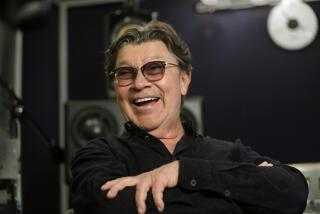The life, art of Paul Robeson
- Share via
Paul Robeson was a great singer and a patriot. He did not separate the two, nor did Willard White in his ardent, animating Royce Hall tribute Thursday night to an American performer who not only moved millions in song but also strove to move millions into taking social action. Robeson was ultimately broken by the effort, and if the modest attendance at this UCLA Live event was an indication, he is not the heroic model he should be today. If anyone can change that, White, a great singer in his own right, can.
Robeson’s rolling basso profundo -- as imposingly deep and rich as Feodor Chaliapin’s yet as velvety smooth and seductive as Frank Sinatra’s -- was the sound Jerome Kern had in mind for “Ol’ Man River” and the inspiration for Gershwin’s Porgy. The son of a former slave, this remarkable singer, overpowering actor, impressive athlete and towering intellectual devoted his life to overcoming racism in America, but he was also a champion for universal human rights. He fought fascism wherever he found it, supporting workers in the mines of Wales, helping Jews escape Nazi Germany, upholding the cause of freedom during the Spanish Civil War. And he did so with a majestic dignity unmistakable in every record he made and every film he appeared in.
Dignity, dramatic intensity and a voice that, were it a tree, could only be a deeply grounded and majestic redwood are also the characteristics of White. Standing on the bare Royce stage Thursday, wearing shirt and slacks, he did not try to channel Robeson as much as evoke what Robeson meant to him. With an outline of Robeson’s life read by the British pianist and arranger Neal Thornton and a few words of Robeson’s mellifluously intoned by White, this was an evening of Robeson seen through the eyes of another and mainly heard through the voice of White.
The songs were vintage Robeson. That meant, of course, spirituals -- Robeson was the first to sing spirituals in concert settings. It also meant popular songs of Robeson’s day, folk songs and protest songs. Thornton’s arrangements gave a jazz tint to much of the material, freshening it up for modern listeners and allowing White to make the songs his own.
It was in making the songs his own that White also captured Robeson’s spirit most fully. Hoagy Carmichael’s “Lazy Boy” flowed easily. “Down by the Riverside” so roused his listeners that, had White handed out placards, he could have inspired an antiwar demonstration on the Royce lawn at intermission. But it was the same thing that made both extremes riveting: By focusing on making every word a compelling utterance, White seemed to burn the songs’ meanings into his listeners’ psyches. He simply made you pay attention.
White moved little, but when he did -- when he put his large, expressive hands up or down, when he moved them gracefully like a bird’s wings -- the effect was extraordinarily effective. Gestures and song were as one, each serving the other, and thus a kind of social symbol of ways in which there need be neither master nor slave.
Yet for all the wondrous ways in which this tribute illuminated Robeson’s life and art, it didn’t go quite far enough. No mention was made of Robeson’s folly, his having been snookered by Stalin. In his determination to find a system that afforded social justice, Robeson was taken not only with the social equality he found in Russia in the 1930s but also by the dictator himself. That ultimately led to the destruction of Robeson’s career by Sen. Joseph McCarthy in the 1950s.
There was no need, so to speak, to whitewash Robeson’s flirtation with Stalin. At the end, White shared his thoughts about troubles, which he likened to sharpening tools for the soul, and it was a perfect way to think about Robeson as well. Nothing ever marred his idealism, nothing can take away from his achievements.
I wish more listeners -- and especially more students -- had been on hand to experience the incredible power of White’s performance. Where at this large university are young people with ideals or mentors to direct them toward heroes?
More to Read
The biggest entertainment stories
Get our big stories about Hollywood, film, television, music, arts, culture and more right in your inbox as soon as they publish.
You may occasionally receive promotional content from the Los Angeles Times.











